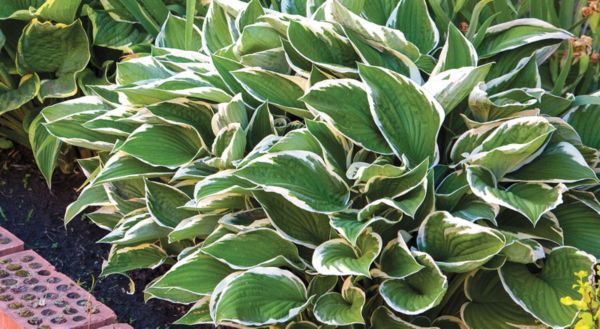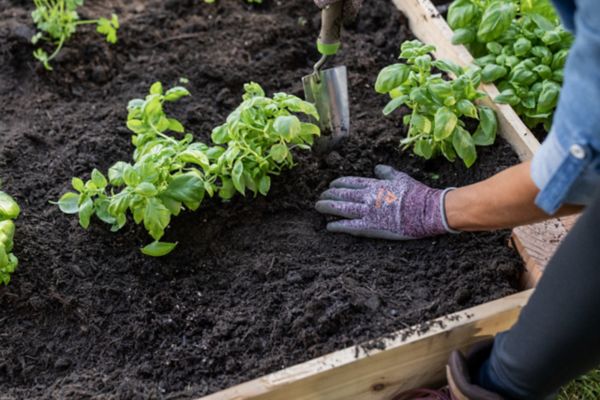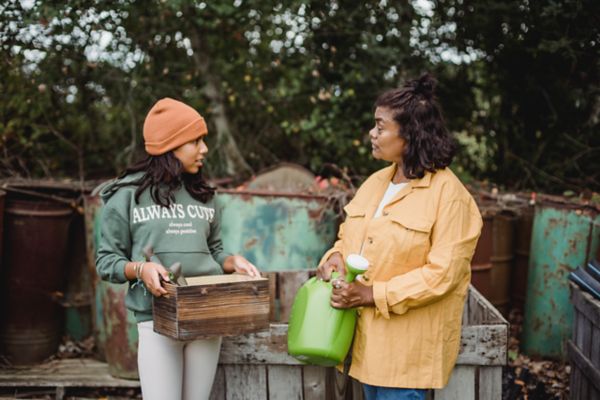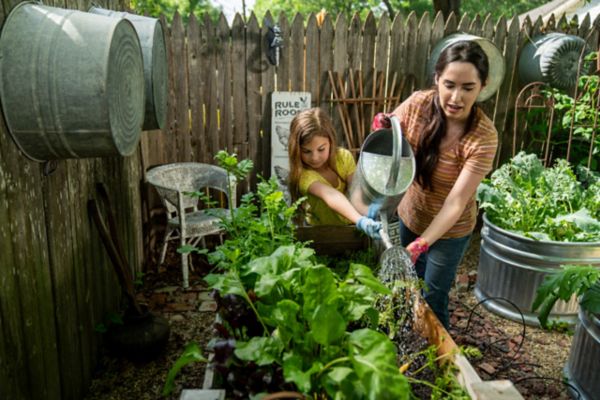How to Grow Hydrangea
Authored by Leah Chester-Davis
Hydrangeas are relatively easy shrubs to grow with minimal effort and big payoff in terms of beautiful blooms and foliage.
Hydrangeas provide big impact in the garden with their bold foliage and their large, dramatic blooms filled with tiny flower clusters. This diverse shrub offers gardeners numerous choices. While bigleaf or mopheads are what most people think of when it comes to this plant, hydrangeas offer many more options, and they are all quite lovely.
About hydrangea
| Botanical name: | Hydrangea macrophylla, H. quercifolia, H. paniculata, H. arborescens, H. serrata, H. anomala |
| Common name: | Bigleaf or mophead or lacecap; oakleaf; panicle; smooth; mountain; climbing |
| Plant type: | Deciduous woody ornamental shrub |
| Size: | 3- to 12-feet tall or more, depending on type and cultivar |
| Sun exposure: | Morning sun, afternoon shade |
| Soil type: | Fertile, well-drained |
| Soil pH: | Acidic to Alkaline; 5 to 5.5 for blue flowers; 6 or more for pink |
| Hardiness zones: | Numerous zones, 3 to 9; your zone may dictate type and cultivar |
| Average first frost: | Varies by region |
| Average last frost: | Varies by region |
| Container friendly: | Yes, compact cultivars |
| Beginner friendly: | Yes |
Growing

Hydrangeas prefer morning sun and afternoon shade. Grow as a single plant or several for greater impact. They like rich, organic, well-drained soil. This plant can be grown in containers and adds striking interest to patios. If growing in a container, use a good quality potting mix. Avoid filling containers with soil from garden beds as it can be too heavy and not drain properly. Look for compact cultivars.
Avoid sites that are hot and dry.
Some hydrangeas will have blooms that are either pink or blue, depending on the pH of the soil. If the soil is acidic with a pH of lower than 6, the blooms will be blue. If the pH is 6 or higher, which is alkaline, the blooms will be pink. Other hydrangeas have colors that are based on the genetics of the plant and you cannot change the color of the bloom by changing the pH of the soil.
Keep track of which kind of hydrangea you are growing as that is crucial when it comes to pruning the plant. Hydrangeas typically grow 4- to 12-feet, depending on the variety. They are fast growers.
Types of hydrangeas
Bigleaf hydrangea
Hydrangea macrophylla, is one of the favorites. It is often called mophead, thanks to the large, ball-shaped flowers. An amazing characteristic of mopheads is their ability to change bloom color depending on the pH of the soil. Acidic soils result in blue blooms and alkaline soils pink blooms. Cultivars range from 4- to 6-feet tall. Some newer cultivars have white blooms. Prune as blooms start to fade and before Aug. 1.
Lacecap hydrangeas
H. macrophylla, is considered a bigleaf hydrangea but its bloom is quite different from the mophead blooms. Lacecaps get their names from the intricate detail of airy clusters of small, tight florets encircled by larger, though delicate florets, which give this plant a totally different appearance from mopheads. Cultivars range from 3- to 6-feet tall. Prune as blooms start to fade and before Aug. 1.
Oakleaf hydrangeas
H. quercifolia, is striking for its large, cone-shaped flower clusters and its large, foliage that resembles oak leaves. Flower buds are formed on previous year’s growth. Prune as flowers start to fade unless you want to keep them for winter interest. In the fall, the foliage turns beautiful shades of bronze, purple, and maroon. The flowers typically change from lighter colors in the summer to pinks and darker colors in the fall. Cultivars range from 3- to 10-feet tall. For smaller spaces, look for compact cultivars.
Panicle or PeeGee hydrangea
H. paniculata, grows in colder locations than the bigleaf types. It gets its name from the large, white, cone-shaped flower clusters. As the summer season moves into fall, the flowers change from white to pink shades, and then to tan in winter. It blooms on new wood so prune in fall, winter, or early spring. Grows from 4- to 12-feet tall. Look for compact cultivars for smaller spaces or grow into a tree form.
Mountain hydrangea
H. serrata, is similar to the bigleaf lacecap but is smaller and more delicate in appearance. It can handle cooler temperatures because its native habitat is mountainous locations. It blooms on old and new wood. Cultivars grow 2- to 4-feet tall.
Smooth hydrangea
H. arborescens, consists of selections that have blooms similar to the lacecaps and some with blooms like large, ball-shaped mopheads. It grows 8- to 10-feet tall. Flowers grow on new growth, so this plant can be pruned in early spring. This includes the selections of ‘Annabelle’, Incrediball®, and Incrediball® Blush™. Invincibelle® Spirit II boasts deep pink, dome-shaped flowers; a portion of the sales supports breast cancer research. Look for cultivars that range from 3- to 5-feet tall for smaller spaces.
Climbing hydrangea
H. anomala, is a clinging vine with lacecap blooms. It needs a strong structure other than a house or tree on which to grow. Blooms on old wood but will not need pruning the first two or three years as it gets established.
Planting

The best time to plant is in the fall or early spring. Rather than simply digging a hole to plant your hydrangea in, prepare the soil in a larger area such as a planting bed or an area at least two-feet-wide and one-foot deep. Add plenty of composted organic matter and work it into the top 8- to 12-inches of soil.
Make sure the top of the root ball is level with the soil surface. Water thoroughly after planting. Add organic mulch such as pine straw or pine bark around the plant to help keep moisture levels even and to prevent weeds. Water thoroughly after planting.
Hydrangeas like water. Keep the soil evenly moist, but not soggy, throughout the growing season, particularly in the spring when flowers are forming and during the hot summer temperatures when the plant is in bloom.
When to prune is one of the most asked questions about this plant. Some bloom on old wood (previous season’s growth), some bloom on new growth (current season’s growth), and some of the newer cultivars are repeat bloomers and bloom on both old and new growth, making pruning less of an issue. It is important to know which type of hydrangea you have because that is crucial information when it comes to the best time to prune your plant. If you prune at the wrong time you may be reducing or eliminating blooms.
If you are unsure which plant you have, wait until after blooms fade and remove them but avoid pruning after August 1. Bigleaf hydrangeas form flower buds in late summer for the following year. If after August 1, wait until early spring when new growth emerges. Remove any dead stems but leave live stems which likely will have flower buds.
Some hydrangeas will have blooms that are either pink or blue, depending on the pH of the soil. If the soil is acidic with a pH of lower than 6, the blooms will be blue. If the pH is 6 or higher, which is alkaline, the blooms will be pink. Other hydrangeas have colors that are based on the genetics of the plant and you cannot change the color of the bloom by changing the pH of the soil.
Fertilizing
An application of an organic fertilizer or an all-purpose 10-10-10 fertilizer may be beneficial during the growing season. Both can be found at your local garden center. Follow label directions. Water after fertilizing.
- Wait four to eight weeks after planting to fertilize.
- A soil test will provide information on your pH levels. See FAQs for detail on how to change pH for pink or blue blooms for bigleaf hydrangeas.
Controlling Pests, Diseases, and Other Problems
Hydrangeas have few serious problems with insects, pests, and diseases. If leaf diseases show up, it may be Cercospora leaf spot, anthracnose, Botrytis blight, or powdery mildew. Remove and dispose of infected leaves on the plant and on the ground.
- Water the plant at the base of the plant rather than from the top. Water early in the day to allow the foliage to dry before nightfall. If foliar problems persist, fungicidal sprays may be used. Follow label directions.
- Insect pests include aphids, leaftiers, spider mites, and rose chafers. If needed, use insecticidal soap or horticultural oil.
- Japanese beetles seem to like oakleaf hydrangeas. Pick or knock them off into a container of soapy water.
Water the plant at the base of the plant rather than from the top. Water early in the day to allow the foliage to dry before nightfall.
Expert Tips

- Paying attention to your planting site and adding plenty of organic material and working it into your soil before adding your hydrangea is the best way to give your plant a good, healthy start.
- Keep track of the hydrandea type you have in your garden, and prune accordingly to maximize bloom production. If you’re unsure, don’t make drastic cuts unless you are willing to risk a season without blooms.
- Make sure your plants are in soil that drains well. Even though they like water, hydrangeas don’t do well in soil that is poorly drained. It also can cause root rot.
Frequently asked questions
How do I get either pink or blue blooms on my mophead hydrangea?
Follow these guidelines from Georgia Extension. For blue blooms: Dissolve 1 tablespoon aluminum sulfate in 1 gallon of water. Pour into the soil around the base of the plant. Make applications of this mixture in March, April, and May. For pink blooms: Dissolve 1 tablespoon of hydrated lime in 1 gallon of water. Pour around the plant in March, April, and May. Avoid getting the solution on the leaves.
Why don’t my hydrangeas bloom?
This can be due to a few different factors. First, pruning at the wrong time. If you prune your plants in late summer or early fall, you may be removing flower buds for the following season. Winter injury can be another reason plants don’t blooms. Poor cultural conditions without good organic soil and adequate moisture where plants may be too stressed during the summer to set good bud growth for the following year could be another reason.
Is it possible to start new plants with stem cuttings?
Yes. In early summer, remove a 6-inch shoot from the plant and strip it of all but the top leaves. Cut off the top 1/3 to ½ of the leaf. Dip the stem in rooting hormone and place in a small container filled with starter potting mix. Keep the soil moist but not soggy. Place in a clear plastic bag that is tented over the plant. New growth should appear in about two weeks. Transplant in about four weeks.






